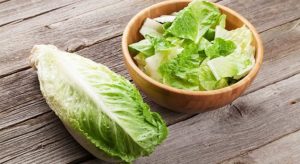Fall’s cooler temperatures are anticipated by everyone who endured the August heatwave with a week at triple-digit temps. While we are waiting for fall, now is a good time to cool off by thinking about growing your cool weather crops, including lettuce. Lettuce, like many things, had moments of scarcity during the beginning of the pandemic.
When needing a garden counts, it is good to know what and how to grow to provide your family with nutritious meals. Lettuce loves the spring and the fall; when temperatures drop your lettuce thrives. Good quality lettuce should be unstressed, have plenty of water and nutrients, and not be crowded. This cool-season crop grows fast and is ready for harvest quickly.
There are four main kinds of lettuce that are grown in home gardens. Crisphead or iceberg, butterhead or bibb, romaine or cos, and looseleaf or cutting lettuce are the main kinds of lettuce. Seed catalogs are filled with four different kinds and many different varieties to choose.
Crisphead or iceberg is a staple at your grocery store; round, tight heads with light green crunchy leaves. Crisphead takes a long, cool growing season lasting up to 85 days. The round, tight head will last longer in the refrigerator than other lettuce.
Butterhead or bibb lettuce has looser, softer heads in a rounded shape. The leaves are known for their buttery flavor. Many of the butterhead varieties are heat resistant and slower to bolt, or go to seed. Their time to maturity is around 75 days.
Romaine or cos has long tall, thick leaves, and is famously used in Caesar salads. Romaine lettuce is both heat and shade tolerant. Most romaine lettuce have a growing period of 65 to 80 days, depending on the variety. Little Gem is the exception with a 50 to 55 day growing period for a smaller, flavorful head.
Looseleaf or cutting lettuce is widely popular in the home garden. These varieties grow fast and do not form heads. Looseleaf lettuces come in beautiful colors like greens, reds, and patterns. Many seed companies have blends available that provide rich colors, flavors, and textures. Growing time elements range from 45 to 60 days to harvest. Many of the leaves are lobed, wavy, or ruffled.
Lettuce is best planted in succession so harvest is not all 25 heads of romaine you grew at once. Lettuce that requires more growth time should have afternoon shade provide by tall crops like corn or caged tomatoes. Lettuce grown in conjunction with other vegetables saves space and protects the lettuce.
Looseleaf and butterhead lettuce do well in greenhouses or hotbeds when the weather is cold. A hotbed has additional heat provided by heating mats, heating cable, steam, hot water, hot air, or manure. Cold frames have a bottomless box with soil contact but without supplemental heat. Both boxes have a clear, removable top that may be opened to regulate and control the temperatures. Both cold frames and hotbeds also help to control pests.
Lettuce has many, many predators. Predators like insects, birds, deer, rodents and rabbits love lettuce. Lettuce planted in an open garden will be attacked from all directions, including the sky. A fenced area with bird netting will help. Diligent guard duty to inspect and remove bugs will protect your crops. A word of caution, do not allow your chickens to do insect hunting in your lettuce, they will just make insect roll-ups and all that will be left is lettuce stumps.
Lettuce is an easy two-season crop that your family will enjoy. The flavors and the nutritional value of home-grown lettuce will impress all. Discover your frost date then work backward to plant your seeds. There are many choices with striking colors that will work in your landscape and on your table.
Julie Silva is a University of California Cooperative Extension Master Gardener of Tuolumne County.
UCCE Master Gardeners of Tuolumne and Calaveras Counties can answer home gardening questions. Call 209-533-5912 or fill out our easy-to-use problem questionnaire here. Check out our website here, You can also find us on Facebook.

